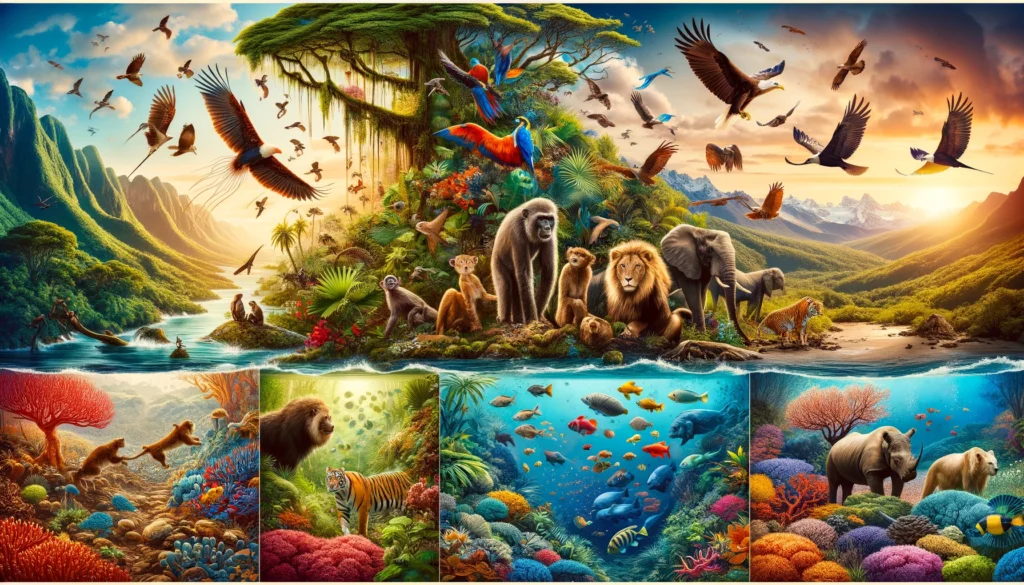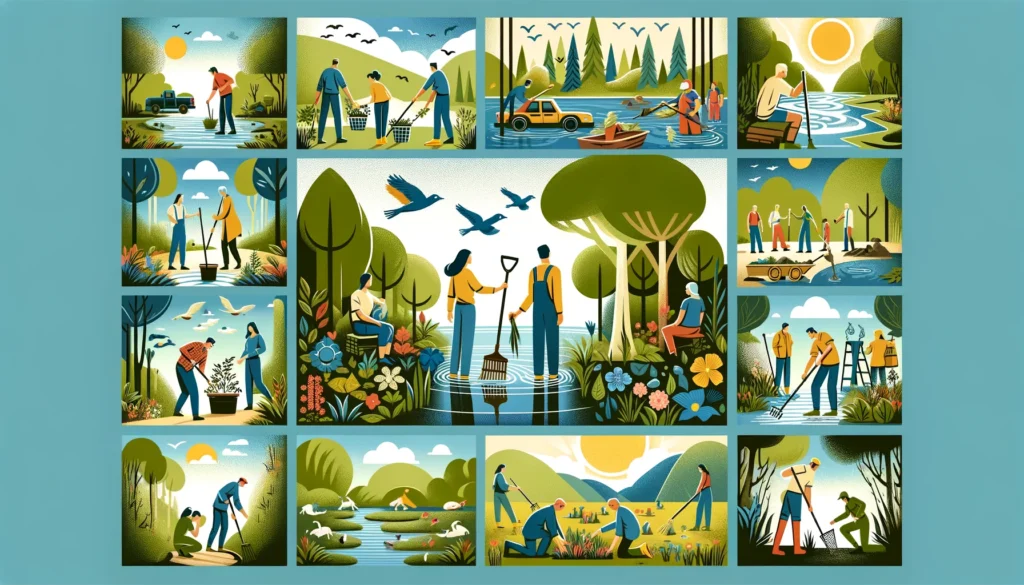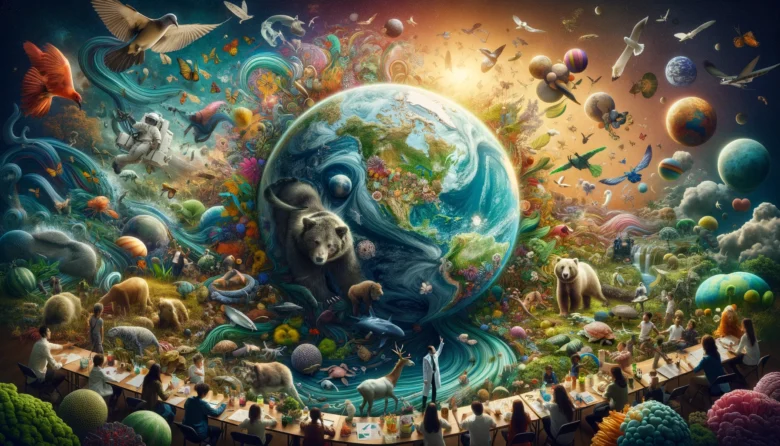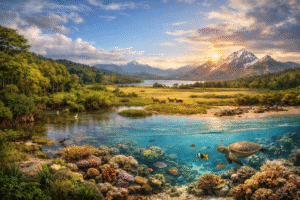Part II: “The Web of Life: Exploring Interdependence and Biodiversity”
The Dance of Interdependence
Interdependence in nature is like a complex dance where each participant, from the smallest insect to the largest mammal, plays a critical role. This interconnectedness means that the survival and well-being of each species are linked to the health of others and the overall ecosystem.
- Life’s Intricate Web: In this dance, plants, animals, and microorganisms interact in a delicate balance. For example, bees pollinate flowers, which leads to the production of fruits and seeds, feeding a variety of creatures and continuing the cycle of life.
- The Human Connection: Humans are integral to this dance. We rely on ecosystems for food, clean water, air, and resources. Our actions, from farming to urban development, have a profound impact on these natural networks.

- A Ripple Effect: The interdependence of life means that a change or disruption in one part of the ecosystem can have far-reaching consequences. The decline of one species can affect many others, highlighting the importance of maintaining biodiversity and ecosystem health.
- Synergy and Support: These relationships are not just about survival but also about providing support and creating synergies that enhance the overall health and resilience of the ecosystem. For instance, forests help regulate the climate and provide habitat for countless species, which in turn support the forest’s health and growth.
- Adaptation and Evolution: Interdependence drives the process of adaptation and evolution, shaping the diversity of life over time. Species evolve not in isolation but in response to their interactions with other organisms and the environment.
Understanding the dance of interdependence helps us appreciate the complexity and beauty of the natural world and underscores the importance of protecting and conserving our shared planet.
Celebrating Biodiversity: Earth’s Living Tapestry
Biodiversity is the rich mosaic of life that forms the living tapestry of our planet. It’s the variety of life forms around us, from the tiniest insects to the largest mammals, and the diverse ecosystems they inhabit, like forests, oceans, and deserts. Celebrating biodiversity means recognizing and valuing the incredible array of life on Earth and understanding its crucial role in sustaining the natural world and our place within it.
- A World of Wonder: Biodiversity offers a fascinating array of life forms, each with unique roles and contributions to the ecosystem. This variety is not just aesthetically pleasing but is essential for the resilience and functionality of ecosystems.
- Ecosystem Services: The diverse life forms and ecosystems provide vital services that make Earth habitable for humans. They regulate the climate, purify air and water, pollinate crops, provide food and medicine, and support cultural and recreational activities.

- Cultural and Scientific Significance: Biodiversity is deeply intertwined with human culture and scientific inquiry. It inspires art, literature, and traditions and is the basis for important scientific research that leads to medical and technological advancements.
- Conservation and Appreciation: Protecting biodiversity is an act of recognizing its value and ensuring its continuity. Conservation efforts aim to preserve species and habitats, while appreciation involves educating ourselves and others about the importance of biodiversity and participating in activities that promote environmental awareness and stewardship.
- Global and Local Actions: Celebrating biodiversity involves actions at both global and local levels. Internationally, agreements and collaborations aim to protect endangered species and habitats. Locally, individuals and communities can engage in actions like planting native species, supporting conservation organizations, and participating in citizen science projects.
By celebrating and understanding biodiversity, we deepen our connection to the natural world and reinforce our commitment to preserving it for future generations, ensuring the sustainability and health of our global ecosystem.
How We Fit In: The Role of Humans
Humans play a critical role in the grand tapestry of biodiversity and interdependence. Our actions and choices significantly affect the health and balance of natural ecosystems. Understanding our place within this intricate network is key to fostering a sustainable relationship with our planet.
- Guardians of Nature: We have the unique ability to protect and enhance the earth’s biodiversity. This involves conserving natural habitats, supporting wildlife protection, and participating in restoration projects to heal damaged ecosystems.
- Sustainable Living: By adopting sustainable lifestyles, we can reduce our environmental impact. This means choosing eco-friendly products, reducing waste, conserving water, and minimizing our carbon footprint through actions like cycling, walking, or using public transport instead of driving.

- Educational and Cultural Shifts: Education plays a vital role in enhancing our understanding of biodiversity and the interconnectedness of life. Cultural changes toward valuing and respecting nature can lead to more responsible behavior and policies that prioritize environmental health.
- Collaborative Efforts: Working together, communities, governments, and organizations can create effective conservation strategies. This includes establishing protected areas, promoting sustainable agriculture and fishing practices, and implementing laws that safeguard natural resources.
- Innovative Solutions: Technology and innovation can offer new ways to protect and restore biodiversity. From citizen science projects that track species populations to advanced conservation techniques, we can leverage knowledge and tools to support the environment.
As part of this global ecosystem, our collective actions can create a positive impact, ensuring that the planet remains a vibrant and nourishing home for all its inhabitants.
Author’s Note
Thank you for joining us in exploring the intricate and vital connections that make up our natural world. As we journey through the realms of interdependence and biodiversity, let’s commit to being mindful stewards of this rich and diverse planet.
G.C., Ecosociosphere contributor.
References and Further Reading
- “The Diversity of Life” by Edward O. Wilson – A comprehensive exploration of biodiversity and its importance.
- “Biophilia” by Edward O. Wilson – Discusses the human tendency to interact with nature and the significance of biodiversity.
- “Half-Earth: Our Planet’s Fight for Life” by Edward O. Wilson – Advocates for dedicating half of the Earth’s surface to nature to preserve biodiversity.





Comments
Can you be more specific about the content of your article? After reading it, I still have some doubts. Hope you can help me.
Thank you for your sharing. I am worried that I lack creative ideas. It is your article that makes me full of hope. Thank you. But, I have a question, can you help me?
Can you be more specific about the content of your article? After reading it, I still have some doubts. Hope you can help me.
Your article helped me a lot, is there any more related content? Thanks!
Your article helped me a lot, is there any more related content? Thanks! https://accounts.binance.com/ar-BH/register?ref=V2H9AFPY